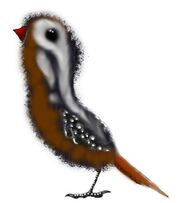INTRODUCTION
Few creatures are stranger than the false panha, the only living member of the Pseudoraptoridae. Being classified first as a glaciotitanid therizinosaur, then as a xenornith, and only recently as an aberrant enantiornith, this creature has gone through as many taxonomic transformations as a Troodon.
SPECIES
False Panha (Pseudoraptor apates)
The false panha is an opposite-bird trying very hard to be a carpo. It is flightless, with the wing separated into two clawed digits, the thumb and digit II (III is tiny and not visible from outside, as usual in Ornithothoraces). The feet are (as usual among birds) anisodactyl, with the 1st toe opposing the other three to provide a strong grip used by these little animals when climbing bamboo stalks. Like rahonavids and xenorniths, these creatures retain gastralia, or belly ribs, which may serve to protect their stomachs or provide muscle attachments, as well as to help in breathing, because false panhas have the smallest breastbones of all birds. The males possess poison glands along the arms which secrete a powerful irritant onto the feathers and claws.
The exact taxonomic position of the false panha is extremely hazy. Scythornis giganteus, the only reliable pseudoraptorid fossil, dates back only to the Pleistocene, and seems to be simply a scaled-up version of the modern Pseudoraptor apates. However, it is clear that the pseudoraptorids are widely separated from the rest of the extant enantiorniths. The poison glands, and some genetic evidence, suggest that their closest relatives are the Twitiaviformes, but these two groups must have diverged very early, probably still in the Cretaceous.
For such an enigmatic animal, false panhas lead rather quiet lives in the highland bamboo forests of eastern Asia. Flightless false panhas clamber nimbly through the stalks, nipping off new shoots where they sprout from the main stem. A false panha's stubby beak is quite sharp and gravel stored in the crop quickly grinds even high-silicate bamboo into something digestible. False panhas dine almost exclusively on bamboo (though young specimens have been seen on the ground digging for invertebrates) and consequently possess pot-bellies which hold large stomachs and endless guts.
Perhaps the strangest feature of the false panha is the poison glands that develop on the males as they approach adulthood. In females, glands situated under and along their arms produce a musky preening oil, but the males' glands secrete a powerful skin irritant. The males rub this secretion over their own bodies and the bodies of their mates and chicks during regular preening sessions. Also and of itself, the oil drips down a series of channeled feathers and into sharp quills at the base of the hands, making formidable weapons that the males use in defense of their families and in dominance battles. While predators that bite down on a poison-coated false panha receive an uncomfortable rash, attackers that have received a swipe from the sharp claws and poisoned quills of a male false panha soon find themselves writhing in agony as the poison is delivered directly into their blood stream.
False panhas live in closely-knit troupes of females and juveniles led by a single dominant male. Young males leave the troupe upon reaching puberty and form "bachelor troupes" that attempt to usurp the territory and females of older males. Only during dominance battles do these normally placid herbivores become violent, slashing at each other with powerful beaks and poison-tipped quills. Challengers are usually defeated by the males already in place (these males having grown quite large during their reigns), but if an old male is defeated, the young one systematically kills all of his predecessor's chicks and mates with the females, assuring the transmission of his own genes rather than those of a competitor. Upon assuming the leadership of a troupe, male false panhas grow enormously until they weigh half again as much as the females. They also develop prominent blue wattles around the face and neck.
False-panha chicks are nearly helpless at birth, and require the care and attention of their troupe for nearly six months before they can fend for themselves. But they grow quite fast for enantiorniths, reaching adult size in little more than a year.
,=Pseudoraptor apates (False panha)
=Pseudoraptoridae=|
`=†Scythornis giganteus


